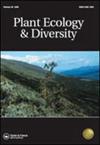Spatial heterogeneity of plant community composition and diversity on phytogenic mounds caused by water erosion
IF 1.6
4区 生物学
Q2 PLANT SCIENCES
引用次数: 1
Abstract
ABSTRACT Background A phytogenic mound is a special microtopography that forms under a perennial plant canopy in erosion-affected areas. These mounds result in spatial microenvironmental heterogeneity and thus are important factors in determining plant community composition. Aims We assessed whether and how plant composition and diversity differed on different parts of mounds in water erosion-affected areas and evaluated which environmental variables were related to the compositional difference. Methods We compared plant community composition and diversity on the upslope (UP) and downslope (DN) parts of mounds and inter-canopy surfaces (IS) along four slope gradients. Results On slopes < 46.6%, vegetation cover, biomass, density and diversity of plant communities did not significantly differ between UP and DN. However, these plant community attributes were higher UP than in IS and DN on steeper slopes (> 46.6%). On such slopes phanerophytes and chamaephytes occurred only UP. Sediment accumulation, light intensity, soil moisture, and surface hardness were significantly correlated with the community composition on mounds, while soil N, P and K showed a weak relationship. Conclusion Only the UP of mounds on steep slopes maintained high plant diversity in water erosion-affected areas, which is especially important for shaping plant community patterns on seriously eroded slopes where plant colonisation is limited.水蚀作用下植物群落组成和多样性的空间异质性
摘要背景植物成因丘是一种特殊的微地貌,形成于受侵蚀地区的多年生植物冠层下。这些土丘导致了空间微环境的异质性,因此是决定植物群落组成的重要因素。目的我们评估了受水蚀影响地区土丘不同部位的植物组成和多样性是否以及如何存在差异,并评估了哪些环境变量与组成差异有关。方法沿四个坡度比较土丘和冠层间表面上坡(UP)和下坡(DN)部分的植物群落组成和多样性。结果在坡度<46.6%时,UP和DN的植被覆盖率、生物量、密度和植物群落多样性差异不显著。然而,在较陡的斜坡上,这些植物群落属性的UP高于IS和DN(>46.6%)。沉积物积累、光照强度、土壤水分和表面硬度与土丘上的群落组成显著相关,而土壤N、P和K的关系较弱。结论在水蚀影响区,只有陡坡土丘的UP保持了较高的植物多样性,这对于在植物定植有限的严重侵蚀斜坡上形成植物群落模式尤为重要。
本文章由计算机程序翻译,如有差异,请以英文原文为准。
求助全文
约1分钟内获得全文
求助全文
来源期刊

Plant Ecology & Diversity
PLANT SCIENCES-
CiteScore
3.30
自引率
0.00%
发文量
26
审稿时长
3 months
期刊介绍:
Plant Ecology and Diversity is an international journal for communicating results and novel ideas in plant science, in print and on-line, six times a year. All areas of plant biology relating to ecology, evolution and diversity are of interest, including those which explicitly deal with today''s highly topical themes, such as biodiversity, conservation and global change. We consider submissions that address fundamental questions which are pertinent to contemporary plant science. Articles concerning extreme environments world-wide are particularly welcome.
Plant Ecology and Diversity considers for publication original research articles, short communications, reviews, and scientific correspondence that explore thought-provoking ideas.
To aid redressing ‘publication bias’ the journal is unique in reporting, in the form of short communications, ‘negative results’ and ‘repeat experiments’ that test ecological theories experimentally, in theoretically flawless and methodologically sound papers. Research reviews and method papers, are also encouraged.
Plant Ecology & Diversity publishes high-quality and topical research that demonstrates solid scholarship. As such, the journal does not publish purely descriptive papers. Submissions are required to focus on research topics that are broad in their scope and thus provide new insights and contribute to theory. The original research should address clear hypotheses that test theory or questions and offer new insights on topics of interest to an international readership.
 求助内容:
求助内容: 应助结果提醒方式:
应助结果提醒方式:


